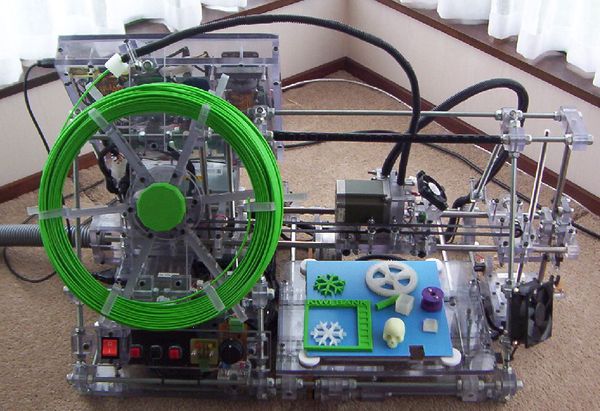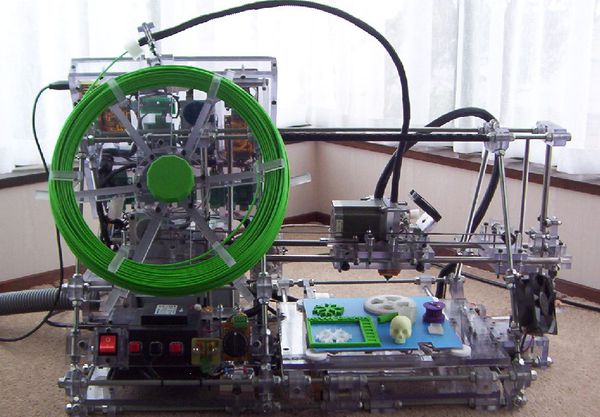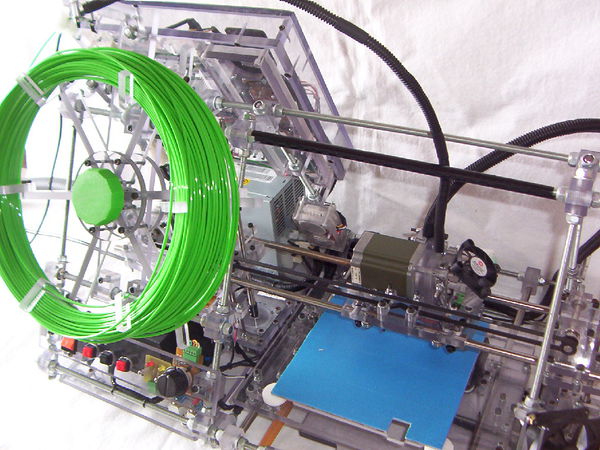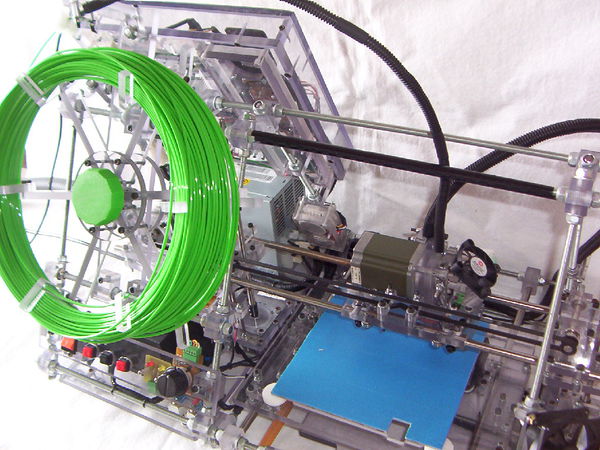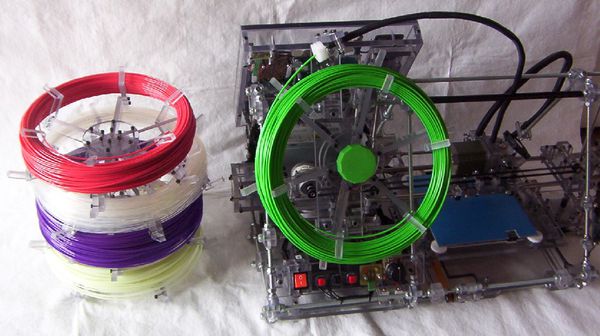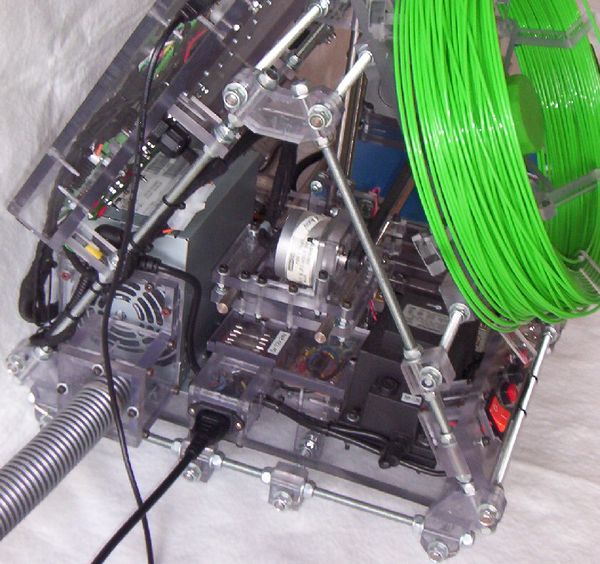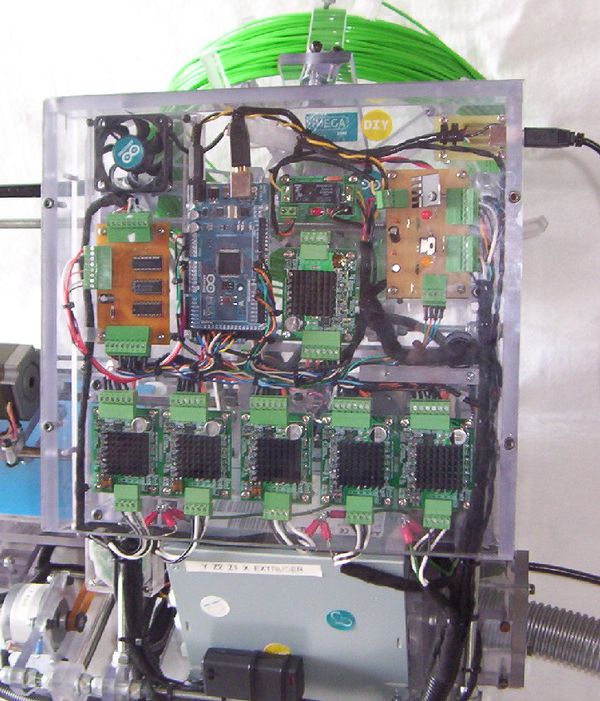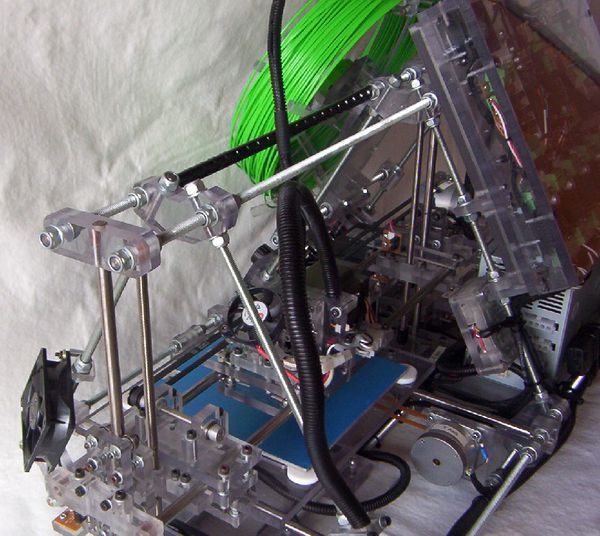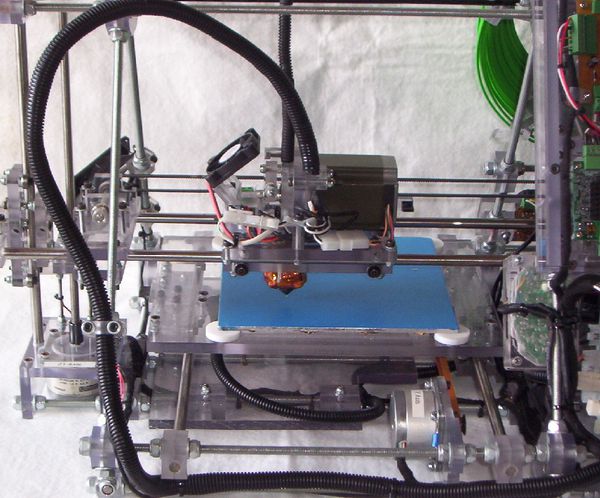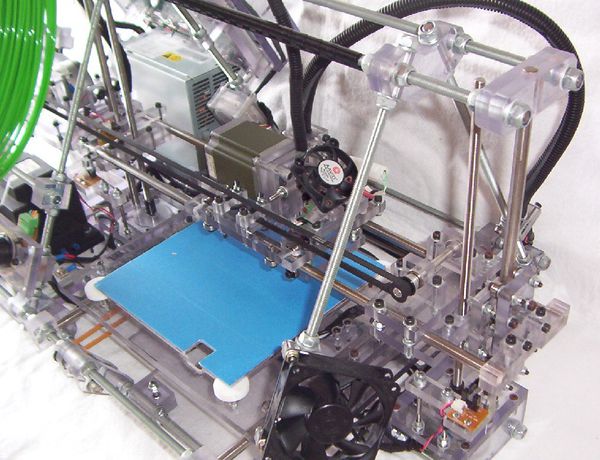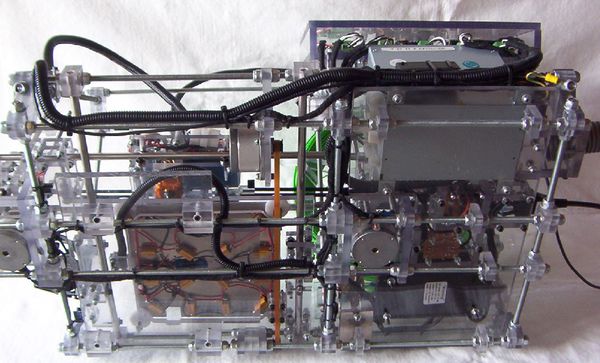Kiwi-M5 Mendel Battle Tank
This page is a development stub. Please enhance this page by adding information, cad files, nice big images, and well structured data!
These are good resources for creating wiki pages. Very Messy Example and Columbus --Sebastien Bailard 07:23, 10 September 2010 (UTC)
Release status: unknown
| Description | Like Mendel but more tank-y
|
| License | |
| Author | |
| Contributors | |
| Based-on | |
| Categories | |
| CAD Models | |
| External Link |
Files - Coming Soon!
| FILE ID# | TYPE | DESCRIPTION | AVAILABLE FORMATS | CREATED/RESERVED BY |
|---|---|---|---|---|
| Your-File-Name | SOLID MODEL ASSEMBLY | These are CAD files for the Solid Model Assembly | .xml.zip, .stl.zip | --Example User 12:00, Today's Date 20xx (UTC) |
| Your-File-Name | CAD FILES FOR PARTS | These are CAD files for each part. | .xml.zip, .stl.zip | --Example User 12:00, Today's Date 20xx (UTC) |
| Your-File-Name | EVEN MORE FILES | These are are even more files. | .xml.zip, .stl.zip | --Example User 12:00, Today's Date 20xx (UTC)|- |
| Your-File-Name | SOLID MODEL ASSEMBLY | This is the final finished machine | N/A | --Example User 12:00, Tomorrow's Date, 20xx (UTC) |
Please edit this and click the red links to put in your own files! --Sebastien Bailard 08:34, 10 September 2010 (UTC)
This Reprap based machine has been built in New Zealand: ---------------------------------------
--- Features ----.
- Built with bullet resistant material.
- Driven with five powerful 24 volt stepper motors.
- Driven with a Arduino Mega 2560 processor. (Without shield)
- Power plant consisting of dual power supplies, 563 watt (main supply) and 150watt (heated bed).
- Massive all-up weight of 25 Kg.
- Long wheel base (Top 2 threaded shafts are 710mm long).
- Loaded and armed with 100metres of 3mm diameter filament ammunition.
- Powerful direct drive filament loading stepper motor.
- 0.5 mm diameter howitzer extruder barrel.
- Target area (Print) - X axis 200mm - Y axis 200mm - Z axis 110mm.
This machine now begining field trials for future battles.... In other words it's printing and being finely tuned....
Having acquired some off-cuts of 10mm clear polycarbonate sheets, I thought this would be a good material to try and build a Repstrap type of machine.
Polycarbonate is what CD’s and DVD’s are made of. Among other things it is also used for bullet resistant windows.
Polycarbonate is a very strong material, it can be easy cut with a hand saw. It can be machined drilled or cut provided machine cutting speeds are kept low to reduce temperature build up. Screw threads can easy be taped by hand.
Note: Polycarbonate is not normally cut using a laser cutter due to the high level of toxic fumes that is produced, however it can be cut using a CNC water jet cutter.
Polycarbonate is not a cheap product to buy, price is around NZ$460 per square meter for 10mm thick sheet pieces.
My aim was to build most of the frame parts from the 10mm Polycarbonate sheets with the least amount of machining. This means some parts will appear to be over engineered.
Due to the complexity of the design, a lot of the work has been, design and build as you go. This has meant some parts have been made and discarded until the design worked. Other designed parts were too hard to machine and a different design part was then made.
The 10mm polycarbonate worked out well in the end for mounting the standard Mendal axis support bearings. Trying to mount the 3 guide bearings at 120 degrees with only using 10mm thick material was going to be difficult, however I found that the bearings being 13mm diameter could be mounted at 90 degrees to each other, e.g. a bearings could be bolted on the flat surface and then the other bearing could be bolted on the edge using 4 mm bolts, this then gives each bearing 1.5 mm exposure on each side of the 10mm sheet pieces. (See pictures of Y and Z axis).
I also found that the 4mm bolts that hold the 13mm bearings could be placed in a drill chuck and by using a metal file the thread could be filed away allowing the bearing to be finely adjusted.
Polycarbonate has a degree of spring tension which can be used to keep the ball bearing running against the guiding surfaces.
A lot of the parts were hand cut then machined in a drill mill. A drill mill is a bit like a bench electric drill press. It has a vice that can be moved by hand in X &Y axis direction. The chuck is replaced with a tool holder that holds slot drills that can be used to cut and shape the polycarbonate. If you use a chuck to hold a slot drill, the sideways force with cutting will cause the chuck to fall off the drill shaft. A mini lathe was used for the odd part - Z axis threaded drive shafts - this was to allow couplings to be fitted to connect the stepper motors, filament spool hub and the filament guides used in the filament spool hose connector to the extruder drive.
Frame:
All of the Mendal frame brackets have been constructed using 2 pieces of machined 10mm Polycarbonate. This gives a 20mm thickness for each bracket. The 8mm threaded shafts nuts then hold these two frame parts together.
The basic Mendal frame design was increased at one end to allow room for two power supplies, (main power supply and a heated bed transformer). The additional frame length also allowed room to mount a spool of filament material as well as being able to mount the electronics and power on-off/reset switches away from the print area.
Increasing the Mendal frame length has increased the overall rigidity of the frame and added to the all up weight to counter vibrations from the movement of the different moving axis parts.
There are around 150 x 8 mm diameter Nylock nuts plus washers. The Nylock nuts were used more for looks, these were a pain to move along the threaded shafts, often I used an electric hand drill turning the threaded shaft and held the nuts with a spanner.
Around 200 x 4mm diameter bolts of 3 different lengths (plus some nuts and washers) have also been used. Some of the 4mm bolts required additional thread, this required using a 4mm die. The die was easy to use as the bolts already had some thread to start with.
Power supplies:
The mains power (230vac) is connected to the machine via a cable lead plug-able power socket. Power is then feed to a power switch which is fitted to the front of the machine and then onto the two power supplies. An earth connection from the main power supply is connection to the Mendal frame and all threaded shafts are bonded together to reduce EMF interference. To bond threaded shafts a wire has been placed under the 8 mm nuts at frame junction areas to connect the threaded shafts together.
A 563 watt power unit that outputs +5volts, +12volts and +24volts has been used as the main power supply. All three voltage outputs go to a housing which contains 3 fuses to provide additional protection in the event of a electrical short circuit. The main power supply which has an internal cooling fan has been mounted to direct the air flow away from the print bed area. A exhaust duct has been installed to enable piping of fumes from the machine environment.
A 150 watt interior lighting transformer (240 volt ac to 12 volt ac) has been used for the heated bed. A 20amp solid state relay is used to switch the output of the transformer (12Vac) to the heated bed resistors.
Headed Bed:
The heated bed is a 200mm x 200mm - 4 mm thick aluminum plate fitted with 16 x 15 Ohm 10 watt resistors. The 16 (15 ohm) resistors and sensor have been glued with thermal glue (Fisher Elektronik WLK5 Adhesive rated at 150C ). A Dallas one-wire digital sensor is used to monitor the temperature.
I had previously built this heated bed for a Darwin which had a separate controller. As I have run out of thermal glue and this glue is not cheap, I have used a PIC Microchip processor, programmed to convert the digital temperature from the Dallas one wire digital sensor reading to a DC signal that matches a thermocouple output. This DC output signal is for the extruder processor to monitor and control the temperature of the heated bed. I am planning to reprogram the extruder processor to accept one-wire input from the heated bed sensor sometime in the future and this will allow the removal of the PIC processor work around.
The aluminum headed bed plate is positioned 6 mm off the Y axis polycarbonate plate with four screws and four PTFE spacers located at the plate corners . The Y axis polycarbonate plate that supports the heated bed, has been cut out in the middle to give clearance for the bed heat resistors and to provide air flow to stop the surrounding polycarbonate from heating up and wrapping. Three of the heated bed plate mounting holes on the Y axis polycarbonate plate have been slotted to allow thermal expansion of the heated bed.
Warm up time for the heated bed to go from 20˚C to 55˚ C takes approx 3 minutes - 15 seconds, about the same time as the extrude heater takes to reach 190 ˚ C.
Stepper Motors:
Five 24 volt stepper motors have been used. (1- X axis, 1 - Y axis, 2 - Z axis, 1 - Extruder). I obtained these from a scrapped automatic cash machine (ATM). The large extruder one is the one that feeds your money out to you.
Two direct drive stepper motors have been used for the Z axis. Each of these stepper motors have their own LED home sensors as well as separate stepper driver boards. An additional PCB is used to allow theses two Z stepper motors to auto synchronize when being sent to their home position. Basically the stepper motor driver boards don’t receive step pulses if the LED sensor is blocked when the motor is being driven in a backwards direction towards the home sensor. The Z axis home signal is only sent to the processor when both LED home sensors are blocked. This also stops the processor ramming the extruder heater barrel into the bed plate should the processor ignore the LED sensor signal for any reason. [For circuit refer to schematic picture...]
All stepper motors cables (2 sets of twisted pairs) have an un-insulated wire that has been wrapped with tin foil and covered with heat shrink. This wire is also connected to the stepper motor and frame ground to shield the electronics from EMF interference.
I found that mounting the Z stepper motors facing upwards (e.g. output shaft upwards) that the output shaft bearings were spring loaded. This could change the position of the Z axis, subject to the supported weight. (This only occurs with some types of stepper motors). The stepper motor bearing springs were replaced with fixed washers to keep an accurate Z axis position.
X Y Z Axis:
The X Y Z axis are all guided with standard 13 mm diameter Mendal ball bearings at 90 degree angles.
12 bearing were used for the X axis.
10 bearing were used for the Y axis.
10 bearing were used for the Z axis.
2 larger bearings that allow the use of ¼” shafts were used to on the X axis drive belt (opposite end to stepper motor).
2 larger bearings that allow the use of ¼” shafts were used to on the Y axis drive belt (opposite end to stepper motor).
The Z axis threaded drive shafts lift nuts are designed to self align. Basically they are allow to move back and forth and left and right but not to rotate. This is to reduce any binding with misalignment of the Z drive shafts/stepping motors.
The X axis stepping motor has been mounted on its side to reduce the use of multiple bearings. A single continuous drive belt is used to move the extruder. Belt tension can be adjusted by moving the complete stepping motor assembly or the belt holding clamps on the extruder.
The Y axis stepping motor is mounted on the inside of the Mendal frame. Belt tension can be adjusted by moving the stepping motor.
Electronics:
The electronics circuits are located on the back of the Mendal frame in an enclosed polycarbonate box. The box assembly is enclosed except for an opening along the bottom edge to allow electrical cabling and an upwards air flow.
A 12 volt PC CPU fan has been installed at the top of the electronics box to provide air movement from the electronics enclosure box. The 12 volt PC CPU fan is connected to the +5volt supply to provide a slow and quiet air flow.
An Ardiuno Mega 2560 processor controls the machine. Breadboard jumpers have been used to connect signals from the processor to the driver PCB's.
Some of the purchased jumpers needed to lengthened. (I used heat shrink when joining additions to these jumper wires).
Previously a sanguino processor was used, with upgrading this to an Arduino Mega the USB conection needed to be extended. This required a USB connector being mounted on a piece of vera board that could be screwed to the electronics box.
I found it was good to be able to monitor both the extruder and bed heater power signals when using the Reprap. The extruder and bed heater driver PCB has LED's for this, but as the electronics box is located at the back of the machine, these LED's are not visable from the front of the machine. I fitted a couple of LED's on a PCB on the front power/ reset switch panel and ran wires back to the solid state relay and extruder connector on the driver PCB..
- Having an extruder and bed heater power LED's visable gives a good indication whether extruder/bed is up to temperature (eg. flashing) and things are running correctly without having to monitor the PC screen. It also would show if a smoke condition accured whether it was being caused by continous power being supplied to a heater. eg. Driver transistor shorted. KiwiM5-k.jpg
PCB’s contained within the electronic enclosure:
- Custom build sensor and Z axis PCB. (Controls the two Z stepper motor signals and allows for auto synchronize of the two Z stepper motors).
- Ardiuno Mega 2560 processor PCB.
- Customer heater driver PCB. (Extruder and heated bed, note: heated bed driver signal goes to a solid state relay).
The extruder and heated bed temperature sensor signals also pass thru this PCB.
- Six stepper driver PCB’s (One spare stepper driver. Currently the output is not wired up - Future gear pump paste extrude).
Design features: -------------------
- Having the electronics components enclosed allows for greater protection from un-authorization contact with items that may short circuit components.
- The enclosure cover stops the Arduino Mega processor connector header pins (breadboard jumper pins) from falling out.
- Modular construction – separated PCB’s allows quick trouble shooting and cheaper exchange parts replacement.
- A barrier support has been fitted below the heater PCB to stop solder or parts dropping directly onto stepper driver PCB’s should a fault occur that results in a melt down.
- A reset switch has been fitted to the front of the machine alongside the mains power switch.
- Electrical cables have been wrapped in Tessa woven fabric tape. (Designed for bundling cables rather that just insulation. - Don't think you can buy it in NZ).
Extruder Assembly:
A powerful direct drive extruder stepper motor has been used with a Makerbot PTFE and 0.5mm barrel. For the extruder stepper motor to feed the filament, I used a 20 tooth drive gear that I purchased from Small Parts & Bearings Australia PN# GS48-20-0476B0635-3-HS. I filed the teeth of the gear to a sharp point to better grip the filament material. I also used two 13mm bearings bolted together with a M4 bolt on an adjustable spring loaded arm that can be adjusted to provide pressure to hold the filament against the feed gear.
For control of the extruder temperature a thermocoupler has been fitted to the extruder barrel. To stop electricial interference affecting the extruder temperature readings, a thermocoupler PCB interface has been mounted at the extruder assembly close to the thermocouple.
The use of a large extruder stepper motor and a large extruder area has been designed to allow future redesign and experimental work. Future plan is to try 0.3mm custom built extruder barrels and also selectable multiple colour filaments by using just one extruder motor, e.g. different filament pinch wheels that can be engaged as required to feed different colour filament.
Spool assembly:
A feed supply spool that can hold up to 100 metres of filament has been fitted to the front of the machine on the Mendal frame extension. The spool being position at the front is to allow easy loading and viewing of filament feeding.
Two ball bearings have been used to allow the spool to rotate freely. This provides smooth resist free feeding of the filament material . The spool has been mounted in a tilted position. One 6mm diameter bolt has been used to mount the spool against the Mendal frame. The spool has a 6 spoke assembly. The filament is held with 6 x U shaped pieces. These U shaped pieces have been angled to be parallel to the base of the machine when position at the top of the spool. The overall theory behind all this is to keep the filament better placed on the spool as the filament is feed off.
A piece of cable holding wrap with 5 nylon guides allows the filament to be pulled by the extruder motor to the print area. Heat shrink has been used to hold the nylon guides in place. The nylon guides which are barrel shaped have been counter sunk drilled to allow easy threading of the filament to the extruder pinch feed.
A block of plastic foam is used to keep the filament clean prior to the filament being feed into the cable that takes the filament to the extruder head assembly. The plastic foam has a cut from the central hole that the filament passes thru to the outside edge to allow easy replacement of the plastic foam.
X, Y, Z Axis Movement: The X and Y axis has a full movement of 200mm x 200mm. The Z axis has 110mm movement. Installing a heated bed and the extruder reduced the normal Mendal 140mm Z axis movement.
By replacing 9 threaded rods (currently 390mm long) with longer ones, plus 4 steel guide shafts( x & y axis) as well as replacing the transformer mounting plate with a larger one and extending the stepper motor and sensor wiring; this would allow the design to have a full 140 mm Z axis movement. This is not something I am planning to do at the moment.
Software / firmware :
Reprap Software = Version 20110207 --------------------- Arduino Firmware setup/loading = Version 22
In ( configuration.h ) --------- I selected '#define DEFAULTS MENDEL_MEGA_DEFAULTS'
To verife/complile firmware in ( FiveD_GCode_Interpreter ) I had to place- ' #include "WProgram.h ' - before - ' #include HardwareSerial.h '
With using an extruder thermocouple and a work around thermocouple bed sensor ( configuration.h ) I de-selected the ' #define TEMP_SENSOR TEMP_SENSOR_RRRF100K_THERMISTOR ' and added ' #define TEMP_SENSOR TEMP_SENSOR_AD595_THERMOCOUPLE '
I then found that when you verife/complile the firmware that an error occurred missing a “)” on the (Pid) page.
I had to edit -
' #if TEMP_SENSOR == TEMP_SENSOR_AD595_THERMOCOUPLE '
' if(!doingBed) {currentTemperature = ( 5.0 * analogRead(temp_pin* 100.0) / 1024.0 '
change this to (temp_pin needs a ')" -
' #if TEMP_SENSOR == TEMP_SENSOR_AD595_THERMOCOUPLE '
' if(!doingBed) {currentTemperature = ( 5.0 * analogRead(temp_pin)* 100.0) / 1024.0 '
Also same with the following -
'#if BED_TEMP_SENSOR == TEMP_SENSOR_AD595_THERMOCOUPLE'
'if(doingBed) {currentTemperature = ( 5.0 * analogRead(temp_pin* 100.0) / 1024.0'
changed this to -
'#if BED_TEMP_SENSOR == TEMP_SENSOR_AD595_THERMOCOUPLE'
'if(doingBed) {currentTemperature = ( 5.0 * analogRead(temp_pin)* 100.0) / 1024.0'
A couple of other setups were required to be edited, eg... x,y,z,e steps per mm, invert X & Y direction, stepper board to ADRIAN_POLOLU_PCB
I have now been able to test all stepper motor movements (including extruder), home end sensors and control both extruder and bed temperatures using the Arduino Mega 2560 and Reprap 20110207 software .
Comparing this with my earlier sanguino processor the Arduino mega 2560 has no issues with having to press the reset before loading firmware.
The Arduino mega 2560 is connected to the +12v reprap power supply (far better that running off USB supply or +5v reprap supply -This reduces voltage drop that can occur with longer wiring and interference issues). If no +12v is present (reprap is turned off) the Arduino mega 2560 will run from the USB power. Allows firmware to be loaded with reprap turned off.
Bill of Materials/Parts List
Parts sourced from:
Mindkits NZ - Arduino Uno Mega processor Qty1 - Pn# Ard_U_Mega + Breadboard jumper wires Qty 3 - Pn# Jumper_wires
Wattsup NZ - Kapton tape for extruder Qty 1 - Pn# Goldfix/Kapton Tape
Element14 NZ - Thermocoupler amplier IC AD595 Qty1 - Pn# 409194, heated bed 15 ohm resistors Qty 16 - Pn# 1545521, thermal adhesive Qty 1 - Pn# 1211723, PIC processor IC, Dallas 1-temperature sensor, connector plugs Pn# 1761546, 1761538 note: min order is 5 but they can be cut down to make small connectors Jaycar NZ - Extruder/bed heater driver transistors (TIP122) Qty 2 - Pn# CAT. NO. ZT2292, Thermocouple Type K qty 1 - PN# CAT. NO. QM1283), IC's - DM74LS00 Qty1 Pn# ZS-5000, DM74LS04 Qty1 - Pn#ZS-5004, DM74LS10 Qty1 Pn# ZS-5010, misc resistors, misc capacitors, misc diodes, blank/veraboard pcb's, etchant, misc wire/cables Pn#WH-3009, interior lighting transformer for heated bed Qty 1 - Pn# N16803, power switch Qty - Pn# SK-0985, reset switch Qty 1 - Pn# SP-0716, power socket Qty 1 - Pn# PP-4005. misc connectors, heat shrink, fuse holders, fuses, small screws/nuts, pcb spacers.
Bunnings NZ -Steel 8mm threaded rod + washers + nuts, Stainless steel threaded rods. Washers for 4mm bolts.
Total Trade Supplies NZ - 4mm bolts +nuts, silver steel shafts.
Local engineering shop NZ - Aluminum heated bed plate
Ocean Controls Australia - Stepper motor driver boards - Pn# KTA-261 Qty 1, KTA-262 Qty 1, KTA-263 Qty 1
Small Parts & Bearings Australia - timing belts Qty 2 - Pn# B-MX-532-063-NF, timing pulley Qty 4 - Pn# P-MX-020-063FF-PFR-AHB-06.350, extruder drive gear Qty 1 - Pn# GS48-20-0476B0635-3-HS, bearings qty 4 - Pn# R4-ZZ-ECO, Coupling Qty 2 - Pn#CR-0635-0635-1905-CDG
Makerbot USA - PTFE barrel, Nicrome wire, thermocoupler pcb
VXB bearings USA - Bearings
Obtained from scrapped bits - Polycarbonate sheets, Main power supply, Stepper motors, LED end sensors. Solid state relay
Give this one some love, eh? --Sebastien Bailard 03:46, 11 January 2011 (UTC)

